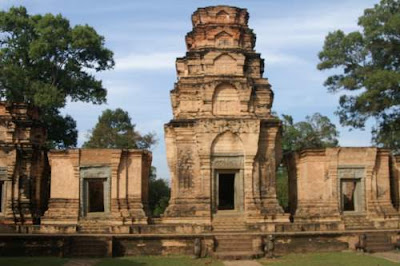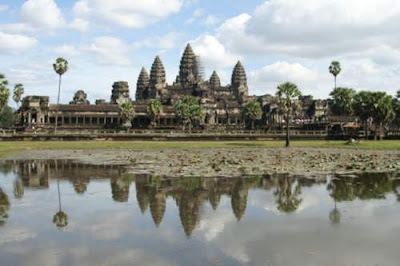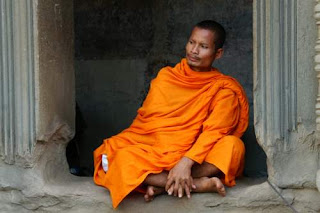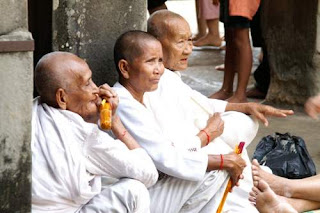 Dear Gentle Reader,
Dear Gentle Reader,Yesterday your humble scribe arrived in Bremen via a long journey by car and by train.
Julia, a very good friend, drove your scribe from Geneva, Switzerland, to Hardt in Baden-Wurttemberg, Germany, just south south-east of Stuttgart, where her parents live.
Upon arriving in Hardt, Julia and her parents surprised your scribe with a traditional German Christmas dinner. Lecker...
Gaensebraten, Kloesse, Rotkohl, und Bratapfel. Lecker. (Roast goose, potato dumplings, red cabbage, and baked/roasted apple. Very tasty.)
After schnapps, coffee, and various specialty Christmas cookies, Julia drove me to the nearest train station where an ICE (InterCity Express) train whisked me from the south to Bremen in the far north.
The train certainly lived up to its InterCity name.
Many towns were visited...
Stuttgart, Mannheim, Frankfurt, Bonn, Cologne, Duesseldorf, Duisburg, Essen, Bochum, Dortmund, Muenster, and Osnabrueck... then, finally, Bremen.
I will tell you more about Bremen on my next hosting of My Town Monday, when I will be in Venice and will truly be having a difficult time reaching anybody. But, yesterday, I promised to show you something very special. I said that I would try to show you the traditional Christmas market in the UNESCO heritage site that is Bremen´s town square.
Imagine a medieval square, centuries old.
There are historical references to people living in Bremen for almost two thousand years. The stone walls demarcating Bremen´s city walls, enclosing people and the regional market, were laid almost one thousand years ago.
That first stone city wall was laid in 1032.
Bremen's market square is bounded by the city hall on one side, the most powerful guildhall, the Merchant´s Guild, on the other side, the Senate House on a third side, and a series of medieval buildings on the final side. The Apotheke, or apothecary, or pharmacy has been here since the 1500´s.
Not much has changed in this square.
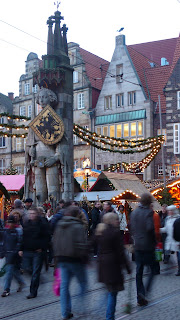 A statue of the knight, Roland, a secular protector of the people with his great sword of justice named "Durendart", faces off against the Bishophric represented by the Cathedral of St. Peter, where your humble scribe and your Heroine were married.
A statue of the knight, Roland, a secular protector of the people with his great sword of justice named "Durendart", faces off against the Bishophric represented by the Cathedral of St. Peter, where your humble scribe and your Heroine were married.Roland has been standing on guard against the Church, in this square, since 1404 when he was commissioned by the Town Fathers in their Rathaus.
The Church has been extraordinarily powerful in secular and economic affairs for centuries, but Bremen is not a Free City for nothing; Bremen´s Rathaus, or Town Hall, has protected the rights of her merchants for years, and merchants rights are nothing without a venue to sell their wares.
The main venue for Bremen´s merchants was the Bremen Market, Bremen´s town square.
So here is Bremen´s town square, just before sunset, on the penultimate day of the Weihnachtsmarkt, Bremen´s traditional Christmas market.
As it has been for centuries, even millenia, the town square, today, was briskly active with buyers walking amongst stalls, examining wares, and proffering money for goods.
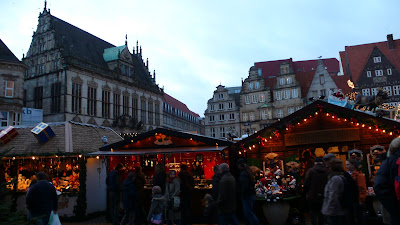
The building at the back of Bremen´s Town Square is the Schütting (Schuetting if your screen does not show umlauts), which is the Guild Hall of the Merchants. More on this next Monday...
Night is falling fast as your scribe races in front of the Bremer Dom, or the Bremen State Cathedral (dedicated to St. Peter but not visible to you, tonight), to take another shot of the historic town square... The Rathaus, or Town Hall, is the building on the right, crowding in the throngs of people who are coming to shop in the square...

And now the light is truly failing as the sun prepares to sleep beneath the horizon...
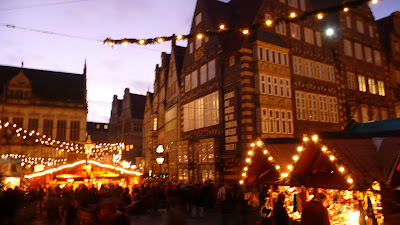 But the Weihnachtsmarkt will continue for the next few hours, picking up steam and revellers as the night grows longer and the Feuerzangenbowle grows stronger.
But the Weihnachtsmarkt will continue for the next few hours, picking up steam and revellers as the night grows longer and the Feuerzangenbowle grows stronger.(Feuerzangenbowle is burnt rum, molten sugar, spices, and red wine... and Feuerzangenbowle translates, sort of, to flaming fire tongs brew. It probably deserves its own post... we will see...)
Bremen´s Christmas market extends for many blocks and over many streets.
Down by the river, the Weser, there is the Middle Ages market, a medieval-themed market where everyone is in costume and they attempt to not be anachronistic...
But your humble scribe has no tripod with him, so there was no chance to take workable pictures in the dark, lit only by flaming torches and firepits...
Besides, your humble scribe´s favourite part of the market is found in Bremen´s historic town square which you have now seen.
After Gluhwein and Bratwurst, your scribe, your Heroine, and her parents headed home to a magnificent dinner of cheeses, meats, and breads.
Your scribe was not so humble regarding his selection of the Brillat-Savarin cheese, truly one of the smoothest and creamiest cheeses on the planet and surely the cheese of the night. You might recall that your scribe considered Jean-Anthelme Brillat-Savarin one of his culinary heroes here...
Your Heroine procured two lovely contenders for cheese of the night, a black truffle enriched brie and a very creamy mascarpone/gorgonzola mix.
The traditional German stinging nettle cheese (Brennesselkaese) also deserved special mention. A German cheese meal without Brennesselkaese is really not a meal at all. The only reason this cheese has not ranked higher is that your humble scribe has this all the time he is visiting, but not so the Brillat-Savarin...
Your scribe will gloss over the next six or seven cheeses, the meats, and the liverwursts, mostly because the deadline for posting is drawing ever nearer, but he must pause briefly over the fantastic Zamburinas in a Viera sauce.
(Sorry, I have no idea how to put the spanish "n"´s mark on that "n" in Zamburinas.)
Zamburinas in a Viera sauce were brought back from Spain... scallops in a reduced sauce derived from another type of scallop... ...magnifique, non?
Well, it is almost nine o´clock, ante meridien, in Hong Kong, which means that your scribe must hurry and post from Bremen, now.
Tomorrow is the last day of the Bremer Weihnachtsmarkt and you can be sure that your humble scribe and Heroine will be back one last time. If you listen you might hear the songs and the laughter, the tinkle of coins, the hiss of the molten sugar, and the gurgling of hot rum and red wine down the throat of your scribe.
Tschuess,
Chris, Regina, and Pommes in spirit if not in spirits















